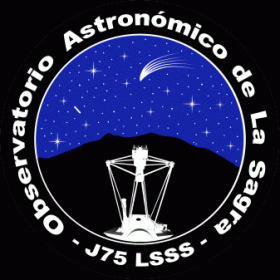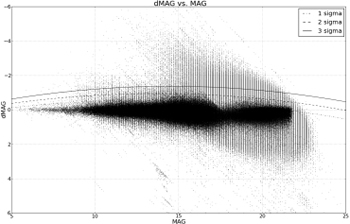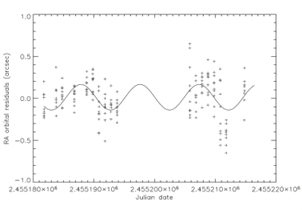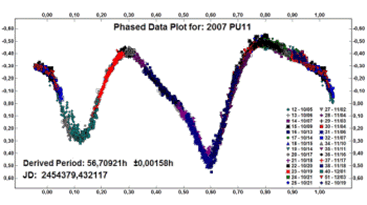Main belt comets
|
It is well known that some Main Belt Asteroids are showing comet-like features. A representing example is the first known "Main
Belt Comet" 133P / (7968) Elst-Pizarro. If the mechanisms causing such activities are too weak to develop visually evident comae or
tails, the objects stay unnoticed. I have been working on a novel search for active asteroids, based on looking for objects with deviations
from their expected brightnesses in a database. Just by using the MPCAT-OBS Observation Archive we found five new candidate
objects for active main belt objects, and the already known "MBC" 133P/(7968) Elst-Pizarro. |
Four of the new candidates, show brightness deviations independent of the object’s heliocentric distance, while one of them has its activity triggered by thermal mechanisms because it shows brightness deviations dependent on heliocentric distance. The method could be implemented in future sky survey programs to detect outbursts on main belt objects almost simultaneously to their occurrence. Ffind more about this topic in our publication in A&A. |
Trans-Neptunian objects
At the moment I am involved in the research group of dr. Jose Luis Ortiz from Instituto de Astrofísica de Andalucía - CSIC in Granada (Spain), working on physical characteristics of Trans-Neptunian Objects. For imaging we are using remotely controlled telescopes located in San Pedro de Atacama (I16) in Chile and on Cerro Burek (I08) in Argentina. Until now I have contributed to an astrometric and photometric study of the binary trans-Neptunian object (90482) Orcus. From our observations we have been able to derive high-precision relative astrometry and photometry of the Orcus system with respect to background stars. |
|
The right ascension residuals of an orbital fit to the astrometric data revealed a periodicity of 9.7 ± 0.3 days, which is what one would expect to be induced by the known Orcus companion (Vanth). We therefore have revealed the presence of Orcus' satellite in our astrometric measurements.
Read more about this project in our publication in A&A. Lately I have been working also on occultation predictions for several Trans-Neptunian Objects we are interested in. Because the telescopes are producing a lot images, as a side project we run a small survey searching for new objects. |
|
Asteroid lightcurves are helping us to learn about the origin and dynamics of the minor planet system. But beside the scientific importance of photometric observations of asteroids, I like to practise lightcurve photometry on educational projects. Since 2007 I am regularly leading groups at the Visnjan School of Astronomy (VSA). It is a ~1 week summer program for talented high school students interested in astronomy. |
Photometric groups are very popular among the high school students because they contain a lot of different work steps, so each participant finds something satisfying for himself. It includes as much theoretical topics as observing experience on telescopes and data reduction.
One nice example of a photometric group is given in the work report of Visnjan School of Astronomy 2008.
|
From beginning 2006 until the end of 2009 I was involved into the work of the La Sagra Observatory. Observatorio Astronomico de La Sagra (observatory code J75) is located in the mountains of Andalusia in Southern Spain, near the village Puebla de Don Fadrique. Our first discoveries have been scored in August 2006. By improving our search methods, we were able to discover several hundred new asteroids per month and monitor tens of thousands of known ones. Since August 18, 2008 La Sagra Sky Survey is officially classified as a survey by the MPC. My contribution to the project was performed in the area of data acquisition and reduction techniques but also in many technical work putting new instruments in operation. |
 |
During my activity at La Sagra Observatory, I collected over 1500 hours of observing experience and there were discovered over 3100 minor planets, including 1 comet and 12 Near Earth Asteroids. For more informations about La Sagra Sky Survey, please visit www.minorplanets.org/OLS/. |
|
Meteors are sometimes followed by certain acoustic sounds. This sounds can be divided into two groups: normal sounds (e.g. hypersonic booms) and electrophonic sounds (anomalous sounds or electrophones). The normal sound is an acoustic wave generated by the meteor airburst in the lower atmosphere, which propagates at the speed of sound. This is the reason why we hear it a few minutes after the appearance of the meteor. Electrophonic sounds are generally heard simultaneously with the meteor’s appearance. These sounds, therefore, cannot be explained by an ordinary acoustic propagation. Normal sounds have been extensively studied for several decades. In contrast, electrophonic sounds have been scarcely studied due to their non-intuitive nature and extreme rareness of the phenomenon.
|
The physical explanation of electrophonic sounds infers an emission of the electromagnetic waves from a fireball with the frequency of audible sound (20 Hz to 20 kHz, ELF-VLF spectral region). These waves propagate at the speed of light which means that they reach the observer without notable retardation. Finally, the sound is created by coupling the electromagnetic energy at audio frequencies with objects on the ground. The main goal of our project is to search for correlations between meteors in the visual spectral region, and the ELF/VLF observations from our antennas. Our instrumental setup is situated at the Tican Observatory, located 3 km from Visnjan in Croatia. With the goal to cover the whole spectral region between ELF and VLF, we use 2 different antennas. The spectral region between 3 and ~1000 Hz are covered with the "Schumann antenna". It is a E-field ball antenna, with a ball diameter of 0.85-m, isolated from the ground on the height of about 4.4 m. The second antenna which we use is an E-field VLF receiver. It looks just like a long wire, and is covering the spectral region between 1 and ~10 kHz. Read more about this project here. |
- Impacts in our Solar system Last update: January 2015 |




